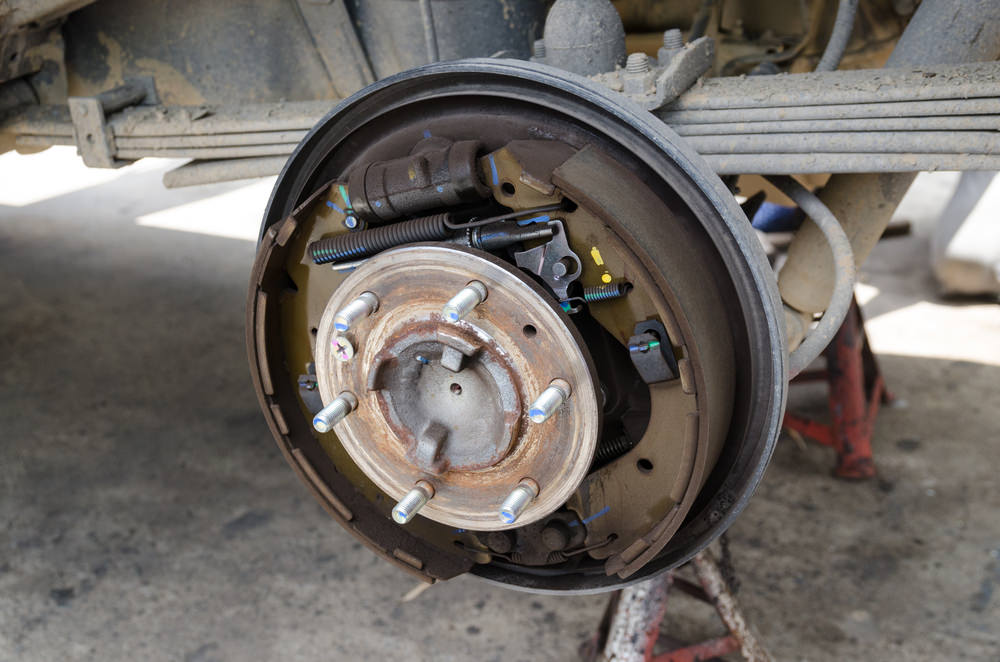

Some vehicles use a brake system comprised partially of drum brakes. They are called such because they use friction applied to metal drums attached to the wheels to slow and stop a car. While disc brakes offer better braking performance and have become more common on modern vehicles, drum brakes are still used in certain applications. Drum brakes are sometimes found on the rear wheels of entry-level cars for cost savings, and in classic cars.
Parts that make up the drum brake system
Backing plate: Provides a solid base for other components in the drum brake. Attached to the axle sleeve.
Brake drum: Bolted to the wheel hub and spins with the wheel. Often made of cast iron, and is resistant to heat and wear. This is what you see when you look at an assembled drum brake, and is the component upon which braking force is applied to slow or stop the car.
Wheel cylinder: Contains two pistons, one at each end of the cylinder, to operate the brake shoes. The cylinder applies pressure to the pistons, which pushes the brake shoes towards the drum, slowing or stopping the car. One cylinder is needed per wheel.
Brake shoe: Pushes into the drum to create the friction necessary to slow or stop the car. Secured to the backing, but able to slide when pressure from the wheel cylinder is applied. Has a lining attached to it made up of organic or metallic compounds. The lining is what actually comes in contact with the drum and wears away with use. Each brake contains two shoes. The primary shoe is closer to the front of the vehicle, while the secondary shoe is closer to the rear. Depending on the type and brand, the brake shoes may be interchangeable.
Automatic adjuster: Keeps the brake shoes at a consistent distance away from the drum, even as the lining wears away.
Return springs: Pulls the brake shoes back away from the drum when the driver lets off the brake pedal.
How drum brakes function
The brakes should respond instantaneously. When the driver presses the pedal, a piston inside the brake master cylinder pressurizes hydraulic fluid in the brake lines, which then pressurizes the wheel cylinder and pushes the shoes into the drum. The harder the driver pushes on the pedal, the greater the pressure inside the brake lines will be, and the more the shoes will press against the drum. The distance the shoes move is small, and the return springs should pull them back away from the drum as soon as the driver lets off the pedal.
Emergency drum brakes
Some vehicles have disc brakes at all four wheels, but still use a small drum brake housed within the wheel hub assembly as an emergency (or parking) brake. When the emergency brake is applied, a lever attached to a cable forces the shoes apart. This provides direct control rather than going through the wheel cylinder or brake hydraulics, which allows the vehicle to stop even if the regular brakes have failed.
Wear and tear on drum brakes
The brake drum and shoes should be the only components that need replacing in a drum brake system. The shoe lining wears away with use, and generally new shoes need to be installed every 35,000 miles, although this depends on your particular vehicle and driving habits. Brake drums can last well over 100,000 miles, but they usually need to be replaced in pairs. Otherwise, the wheel cylinder, automatic adjuster, and return springs should last the lifetime of your vehicle, although mechanical problems or damage from debris or a crash is still possible. However, it’s best to check brake fluid every 24,000 to 36,000 miles, and immediately if you suspect a leak.
Symptoms of problems with drum brakes
There are several symptoms that tip a driver off to problems with their drum brakes.
Noise from the brakes: Since shoe lining wears away with use, excessive or unusual noises could indicate that the lining is low or gone. A technician can inspect why your brakes are noisy, but replacing the brake shoes will often solve the problem.
Shaking or pulsating pedal: If the brake pedal pulsates or shakes when you press it, chances are your drums are warped. Brake drums are meant to be perfectly round, and a warp can form by overuse or overheating. Generally, replacing the drums will fix the issue and restore normal braking.
Spongy or low brake pedal: The brake pedal should have good feel, with braking force consistent with the amount of pressure applied to the pedal. If the pedal feels spongy or lower than usual, it’s often a sign of contaminated brake fluid or a leak in the system. Air or water in the fluid reduces its efficacy, and a leak is a serious problem. Have a mechanic flush the fluid or inspect the system for leaks to restore full braking power. A failing wheel cylinder could also be the culprit for a spongy or low brake pedal.
Brakes are arguably the most important safety system in a car, so stay aware of any unusual symptoms that could indicate a part in your drum brake system needs to be replaced.



